Progress on Single-Feed Quality Wideband Linear Wire Array
Abstract
1. Introduction
- (1)
- A systematic review of the development history of the QWL antenna is presented for the first time, covering advances in its driven element, director, reflector, low-common-mode-current interference connector, and array series-fed feed design.
- (2)
- The analytical expression and a quick design formula for the input impedance of the QWL antenna’s driven element, the linear WHEMS antenna, are provided for the first time.
2. QWL Antenna
3. Driven Element
3.1. Impedance Characteristic
- The WHEMS antenna theoretically has infinite bandwidth, and the module value of input impedance gradually converges to half of the characteristic impedance of half the WHEMS antenna with the increase in frequency;
- The first matching resonant point of the WHEMS antenna is at the first parallel resonant point, that is, when half the WHEMS antenna is equivalent to a half-wavelength short-circuit transmission line. At this point, half the WHEMS antenna has a perimeter of one wavelength.

3.2. Radiating Characteristics
4. Reflectors and Directors
5. Rugged Design
6. Series-Fed Array Arrangement
7. Design Steps of QWL Antenna
- (a)
- Determine the operating frequency range of the antenna.
- (b)
- Set Ω in Equation (1) to define the fundamental parameters of the antenna.
- (c)
- Design the three-dipole array director according to the design principles discussed in Section 4. Following Yagi antenna design guidelines, ensure that the length of each metal rod in the directors does not exceed half of the wavelength at the lowest operating frequency.
- (d)
- Design the W-shaped reflector according to the design principles discussed in Section 4.
- (e)
- Design the voltage balun using the method described in [27].
- (f)
- If implementing a series-fed array antenna, design the series feeding according to the method outlined in Section 6.
- (g)
- Design the low-common-mode-current connector based on the method provided in Section 5.
- (h)
- Finally, optimize the antenna’s design based on the specific application requirements.
8. Discussion and Future Directions
8.1. Conclusions and Discussion
8.2. Future Directions
- (a)
- Designing a broadband high-efficiency director.
- (b)
- Expanding the bandwidth of the QWL antenna by incorporating a broadband high-efficiency director.
Author Contributions
Funding
Conflicts of Interest
References
- Yagi, H.; Uda, S. Projector of the sharpest beam of electric waves. Proc. Imp. Acad. 1926, 2, 49–52. [Google Scholar] [CrossRef]
- Base Station Antenna–Sinclair Technologies. Available online: https://www.sinctech.com/collections/base-station-antennas?pf_t_antenna_type=Yagi (accessed on 30 August 2024).
- Viswanadham, C. A Practical Approach for Controlling the Shape of the Radiation Pattern of a Microwave Log-Periodic Antenna for Wideband Applications [Antenna Applications Corner]. IEEE Antennas Propag. Mag. 2014, 56, 304–314. [Google Scholar] [CrossRef]
- Liu, A.; Lu, J. A UHF Deployable Log Periodic Dipole Antenna: Concept, Design, and Experiment. IEEE Trans. Antennas Propag. 2020, 69, 538–543. [Google Scholar] [CrossRef]
- Huang, D.; Xu, G.; Ding, D.; Wang, W.; Yang, L.; Huang, Z.-X.; Wu, X.-L.; Yin, W.-Y. Wideband Integrated Log-Periodic Antenna Array for 5G Q-Band Applications. IEEE Antennas Wirel. Propag. Lett. 2022, 21, 1428–1432. [Google Scholar] [CrossRef]
- Deal, W.; Kaneda, N.; Sor, J.; Qian, Y.; Itoh, T. A new quasi-Yagi antenna for planar active antenna arrays. IEEE Trans. Microw. Theory Tech. 2000, 48, 910–918. [Google Scholar] [CrossRef]
- Kan, H.K.; Waterhouse, R.B.; Abbosh, A.M.; Bialkowski, M.E. Simple Broadband Planar CPW-Fed Quasi-Yagi Antenna. IEEE Antennas Wirel. Propag. Lett. 2007, 6, 18–20. [Google Scholar] [CrossRef]
- Alhalabi, R.A.; Rebeiz, G.M. High-Gain Yagi-Uda Antennas for Millimeter-Wave Switched-Beam Systems. IEEE Trans. Antennas Propag. 2009, 57, 3672–3676. [Google Scholar] [CrossRef]
- Chu, H.; Guo, Y.-X.; Wong, H.; Shi, X. Wideband Self-Complementary Quasi-Yagi Antenna for Millimeter-Wave Systems. IEEE Antennas Wirel. Propag. Lett. 2011, 10, 322–325. [Google Scholar] [CrossRef]
- Abbosh, A. Ultra-Wideband Quasi-Yagi Antenna Using Dual-Resonant Driver and Integrated Balun of Stepped Impedance Coupled Structure. IEEE Trans. Antennas Propag. 2013, 61, 3885–3888. [Google Scholar] [CrossRef]
- Wu, J.; Zhao, Z.; Nie, Z.; Liu, Q.H. Design of a Wideband Planar Printed Quasi-Yagi Antenna Using Stepped Connection Structure. IEEE Trans. Antennas Propag. 2014, 62, 3431–3435. [Google Scholar] [CrossRef]
- Yeo, J.; Lee, J.-I. Bandwidth Enhancement of Double-Dipole Quasi-Yagi Antenna Using Stepped Slotline Structure. IEEE Antennas Wirel. Propag. Lett. 2015, 15, 694–697. [Google Scholar] [CrossRef]
- Kaneda, N.; Deal, W.; Qian, Y.; Waterhouse, R.; Itoh, T. A broadband planar quasi-yagi antenna. IEEE Trans. Antennas Propag. 2002, 50, 1158–1160. [Google Scholar] [CrossRef]
- Liang, W.; Qi, Y.; Jiao, Y.-C. A Novel small director array for slot loop antenna for lte application. IEEE Antennas Wirel. Propag. Lett. 2013, 12, 1110–1113. [Google Scholar] [CrossRef]
- Hwang, I.J.; Ahn, B.; Chae, S.C.; Yu, J.W.; Lee, W.W. Quasi-yagi antenna array with modified folded dipole driver for mmwave 5g cellular devices. IEEE Antennas Wirel. Propag. Lett. 2019, 18, 971–975. [Google Scholar] [CrossRef]
- Wei, F.; Wang, J.X.; Zhao, X.B.; Zeng, C.; Hou, J.Q. Balanced-to-single-ended four-way out-of-phase power divider and its application to broadband balanced quasi-yagi antenna array. IEEE Antennas Wirel. Propag. Lett. 2020, 19, 1370–1374. [Google Scholar] [CrossRef]
- Alekseytsev, S.A.; Gorbachev, A.P. The novel printed dual-band quasi-yagi antenna with end-fed dipole-like driver. IEEE Trans. Antennas Propag. 2020, 68, 4088–4090. [Google Scholar] [CrossRef]
- Qi, Y.; Zhu, L.; Chen, X.; Wang, W. Wideband Slot-Loop Antennas for Wireless Communication Systems. U.S. Patent No. 6,259,416, 10 July 2001. [Google Scholar]
- Chi, L.; Qi, Y.; de Paulis, F.; Zhang, Y. A Compact wideband antenna with an orthogonal radiating choke for broadside gain enhancement. IEEE Open J. Antennas Propag. 2022, 3, 902–910. [Google Scholar] [CrossRef]
- Xiao, Y.; Qi, Y.; Li, F.; Fan, J.; Yu, W.; Lu, L. Dual-Band Directional Slot Antenna for Wi-Fi Application. IEEE Trans. Antennas Propag. 2018, 66, 4277–4281. [Google Scholar] [CrossRef]
- Wu, S.; Chi, L.; Li, F.; de Paulis, F.; Qi, Y. A Compact High-Isolation Wideband Three-Sector Linear Array. IEEE Trans. Antennas Propag. 2021, 70, 3094–3099. [Google Scholar] [CrossRef]
- Chi, L.; Weng, Z.; Qi, Y.; Drewniak, J.L. A 60 GHz PCB Wideband Antenna-in-Package for 5G/6G Applications. IEEE Antennas Wirel. Propag. Lett. 2020, 19, 1968–1972. [Google Scholar] [CrossRef]
- Wen, H.; Qi, Y.; Weng, Z.; Li, F.; Fan, J. A Multiband Dual-Polarized Omnidirectional Antenna for 2G/3G/LTE Applications. IEEE Antennas Wirel. Propag. Lett. 2017, 17, 180–183. [Google Scholar] [CrossRef]
- Chi, L.; Qi, Y.; Weng, Z.; Yu, W.; Zhuang, W. A Compact Wideband Slot-Loop Directional Antenna for Marine Communication Applications. IEEE Trans. Veh. Technol. 2019, 68, 2401–2412. [Google Scholar] [CrossRef]
- Chi, L.; Qi, Y.; Weng, Z.-B.; Yu, W.; Li, F.; Drewniak, J.L. Directional Antenna with Consistent H-Plane Dual-Band Beamwidth for Wi-Fi Applications. IEEE Trans. Antennas Propag. 2019, 67, 4495–4505. [Google Scholar] [CrossRef]
- Cai, Z.; Zhou, Y.; Qi, Y.; Zhuang, W.; Deng, L. A Millimeter Wave Dual-Lens Antenna for IoT-Based Smart Parking Radar System. IEEE Internet Things J. 2021, 8, 418–427. [Google Scholar] [CrossRef]
- Chi, L.; Weng, Z.-B.; Meng, S.; Qi, Y.; Fan, J.; Zhuang, W.; Drewniak, J.L. Rugged Linear Array for IoT Applications. IEEE Internet Things J. 2020, 7, 5078–5087. [Google Scholar] [CrossRef]
- Cai, Z.; Zhou, Y.; Weng, Z.; Deng, L.; Luo, Y.; Yu, M.; Qi, Y. 3D Printing Conformal K-band Lens Antenna for a Smart Parking Space Detection System. IEEE Trans. Instrum. Meas. 2020, 69, 8514–8525. [Google Scholar] [CrossRef]
- Balanis, A. Constantine. In Antenna Theory: Analysis and Design; John Wiley & Sons: Hoboken, NJ, USA, 2015. [Google Scholar]
- Kraus, J.D.; Marhefka, R.J. Antennas for All Applications; McGraw-Hill: New York, NY, USA, 2003. [Google Scholar]
- Chen, Y.C.; Chen, S.Y.; Hsu, P. A modified cpw-fed slot loop antenna with reduced cross polarization and size. IEEE Antennas Wirel. Propag. Lett. 2011, 10, 1124–1126. [Google Scholar] [CrossRef]
- Hussain, M.; Zahra, H.; Mohsen, A.; Abbas, S.M.; Zhu, Y. PDMS Based Dual Band Flexible Antenna for ISM and WLAN Portable Applications. In Proceedings of the 4th URSI Atlantic RadioScience Conference, Meloneras, Spain, 19–24 May 2024; pp. 1–4. [Google Scholar]
- Hussain, M.; Islam, T.; Alzaidi, M.S.; Elkamchouchi, D.H.; Alsunaydih, F.N.; Alsaleem, F.; Alhassoon, K. Single iterated fractal inspired UWB antenna with reconfigurable notch bands for compact electronics. Heliyon 2023, 9, e21419. [Google Scholar] [CrossRef] [PubMed]
- Fei, P.; Qi, Y.; Jiao, Y.-C. Design of a Wideband dual-element slot loop antenna array with adjustable back-reflector. IEEE Antennas Wirel. Propag. Lett. 2012, 11, 1014–1017. [Google Scholar] [CrossRef]
- Gao, X.; Qi, Y.; Jiao, Y.-C. Design of multiplate back-reflector for a wideband slot antenna. IEEE Antennas Wirel. Propag. Lett. 2013, 12, 773–776. [Google Scholar] [CrossRef]
- Weng, Z.; Chi, L.; Drewniak, J.L.; de Paulis, F.; Zhu, Y.; Qi, Y. An 1.7–2.7 GHz all-weather broadband High-gain antenna with W-shape reflector for maritime communications. AEU-Int. J. Electron. Commun. 2022, 155, 154339. [Google Scholar] [CrossRef]
- Xie, L.; Chi, L.; Lin, B.; Qi, Y. A series-fed high-quality linear array antenna for 5G maritime communications. Microw Opt. Technol. Lett. 2024, 66, e34162. [Google Scholar] [CrossRef]
- Ou, J.H.; Chen, Z.; Bo, S.F.; Zhang, Y.; Zhang, X.Y. Compact dual-polarized antenna with low-pass response for marine communication. IEEE Trans. Veh. Technol. 2021, 70, 2649–2656. [Google Scholar] [CrossRef]
- Han, B.; Wu, Q.; Yu, C.; Wang, H.; Gao, X.; Ma, N. Ultracompact dual-polarized cross-dipole antenna for a 5G base station array with a low wind load. IEEE Trans. Antennas Propag. 2022, 70, 9315–9325. [Google Scholar] [CrossRef]
- Dai, X.-W.; Zhou, X.-Y.; Luo, G.-Q. Wideband directional antenna system with different polarizations for wireless communication system. AEU-Int. J. Electron. Commun. 2017, 75, 119–123. [Google Scholar] [CrossRef]
- Wu, R.; Xue, Q.; Chu, Q.X.; Chen, F.C. Ultrawideband dual-polarized antenna for LTE600/LTE700/GSM850/GSM900 applica-tion. IEEE Antennas Wirel. Propag. Lett. 2021, 20, 1135–1139. [Google Scholar] [CrossRef]
- He, Y.; Yue, Y.; Shen, Z. A Novel broadband dual-polarized antenna element for lte700 MHz/GSM850 MHz/GSM900 MHz applications. IEEE Access 2016, 4, 4321–4326. [Google Scholar] [CrossRef]
- SY4062-Sf5snm(ABK)-Spec-Sheet. Available online: https://cdn.shopify.com/s/files/1/0531/8970/5898/t/7/assets/SY4062-SF5SNM(ABK)-Spec-Sheet.pdf?v=1616003604 (accessed on 14 December 2016).
- SY459-SF1SNM(ABK)-Spec-Sheet. Available online: https://cdn.shopify.com/s/files/1/0531/8970/5898/t/7/assets/SY459-SF1SNM(ABK)-Spec-Sheet.pdf?v=1616003899 (accessed on 4 August 2017).
- SY450-SWBS(XX)(ABK)-Spec-Sheet. Available online: https://cdn.shopify.com/s/files/1/0531/8970/5898/t/7/assets/SY450-SWBS(XX)(ABK)-Spec-Sheet.pdf (accessed on 9 March 2022).



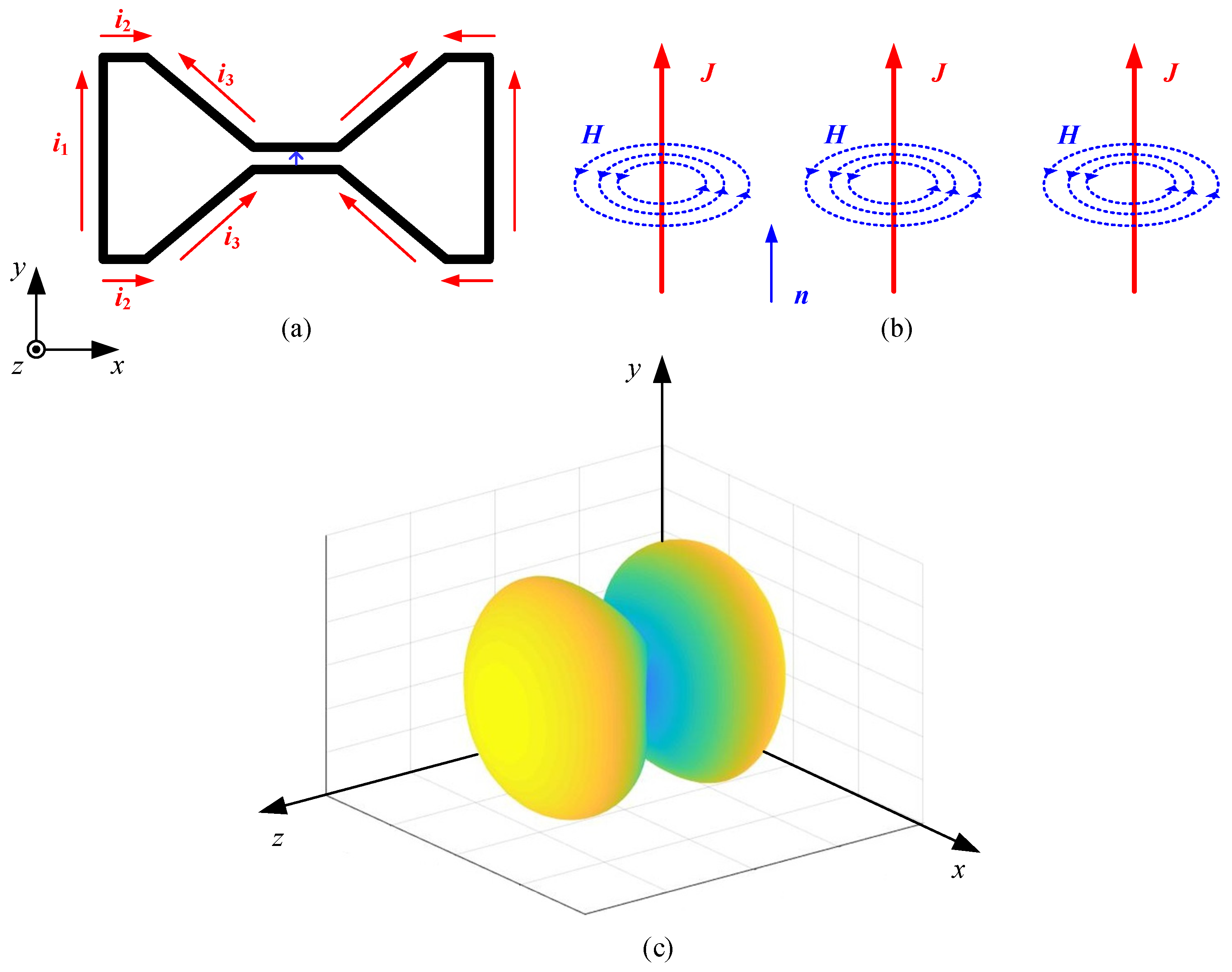
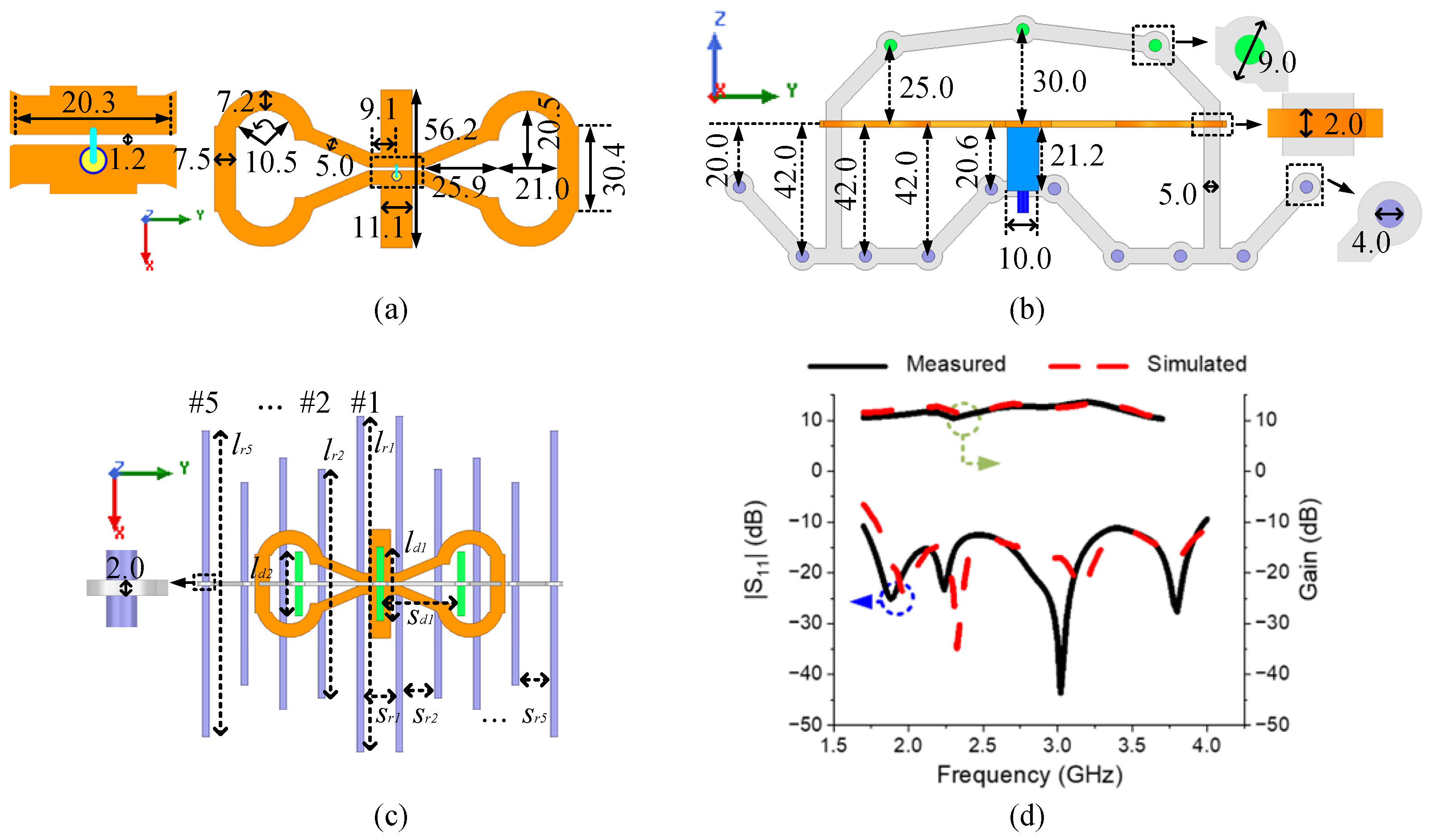
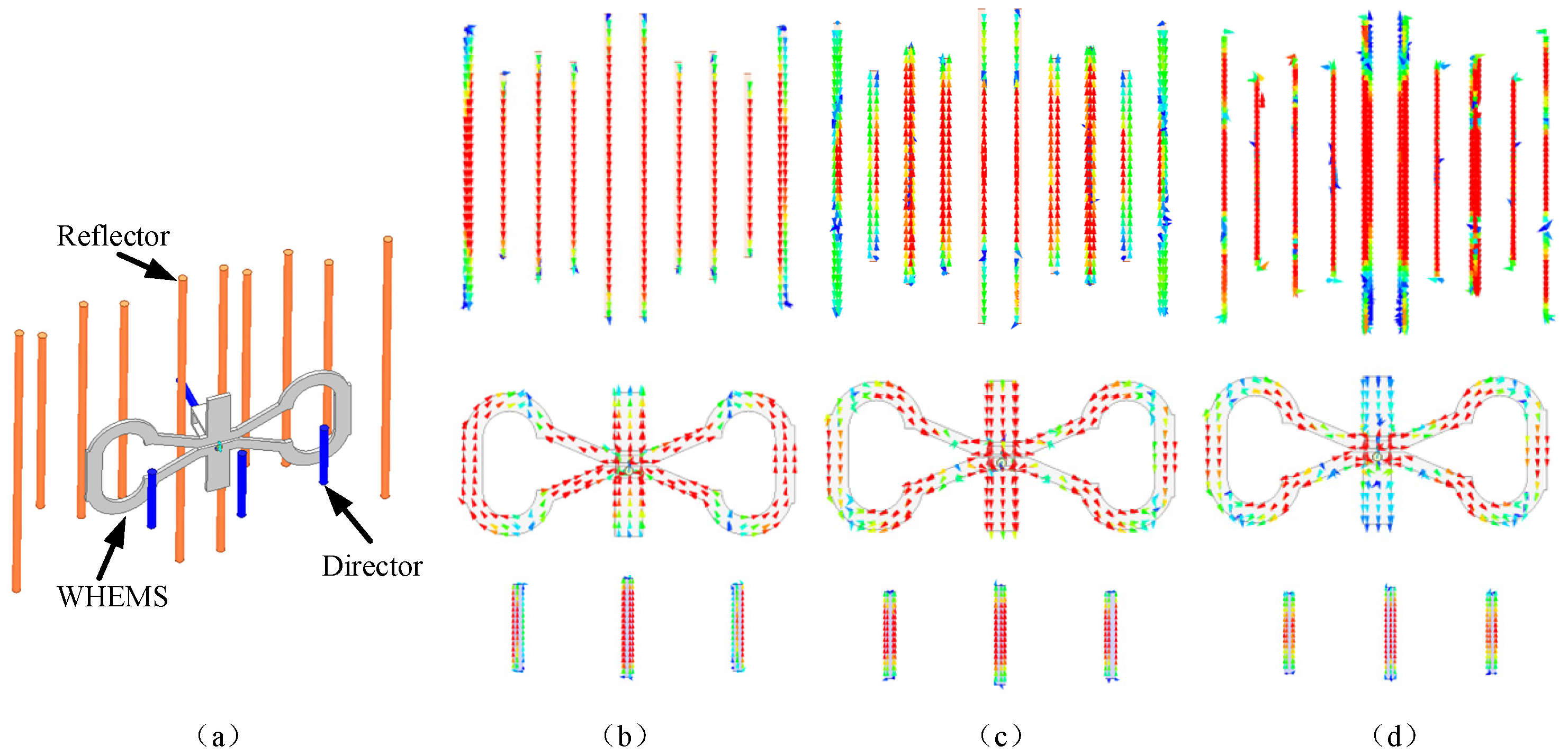
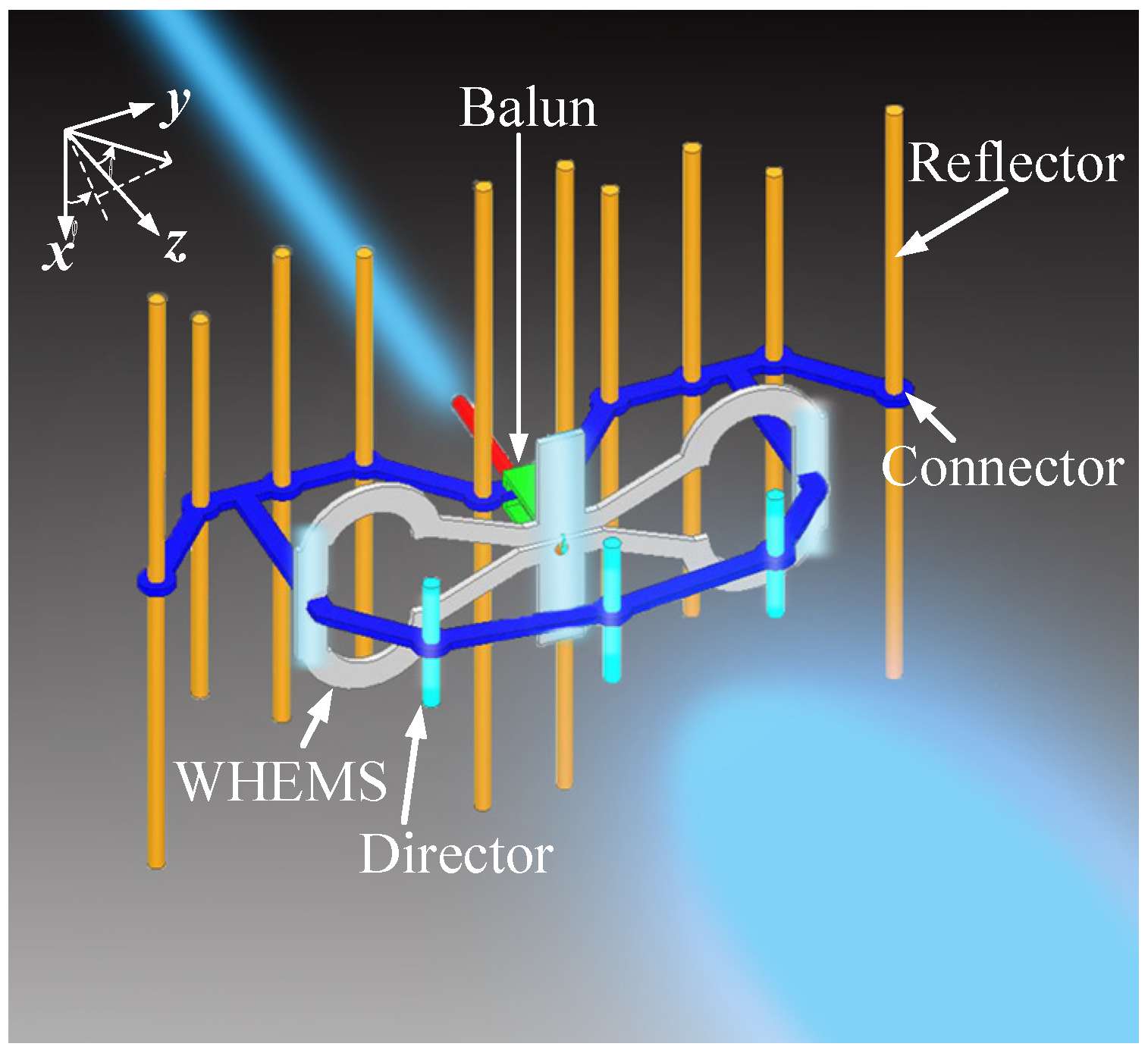
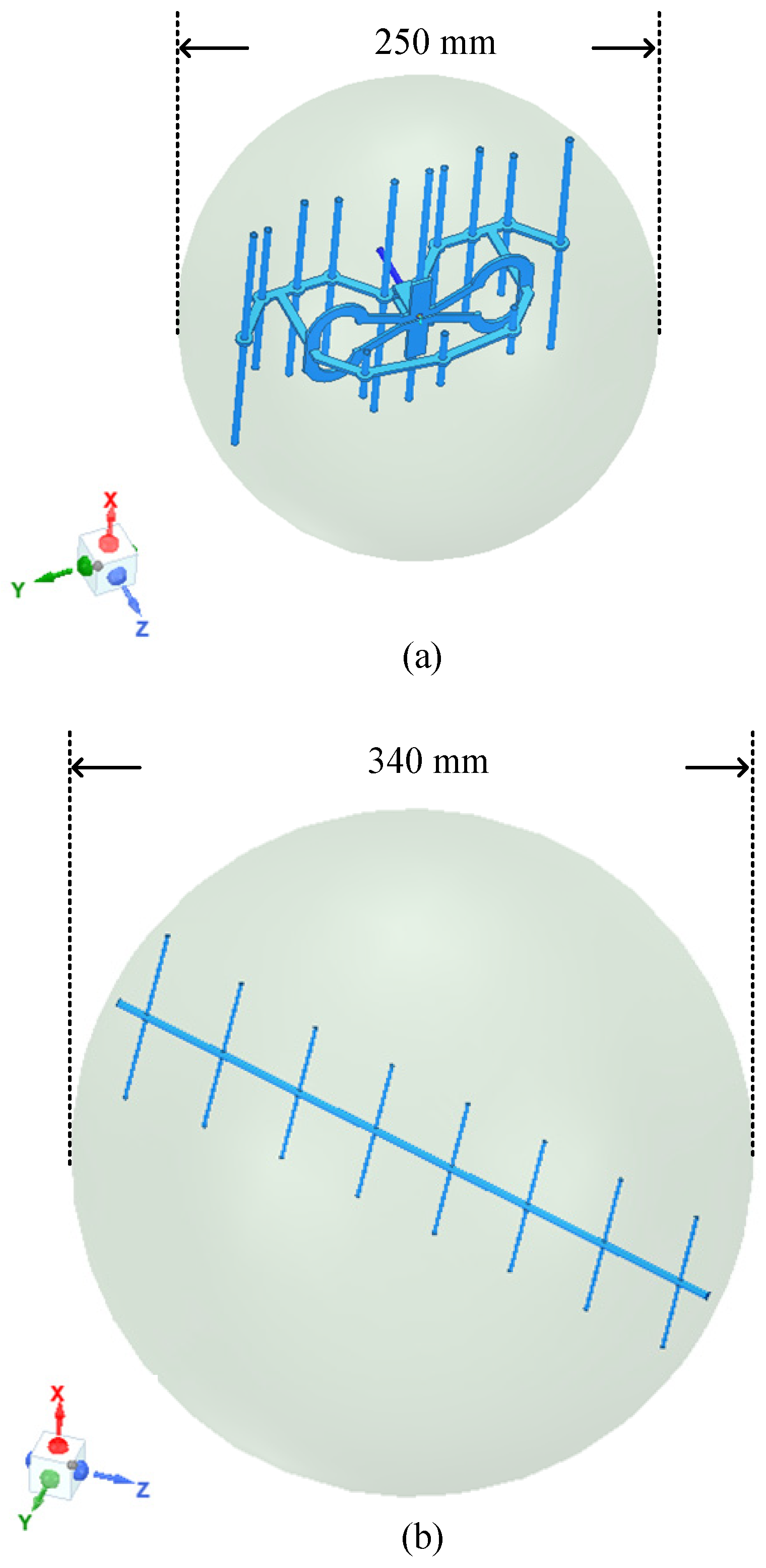

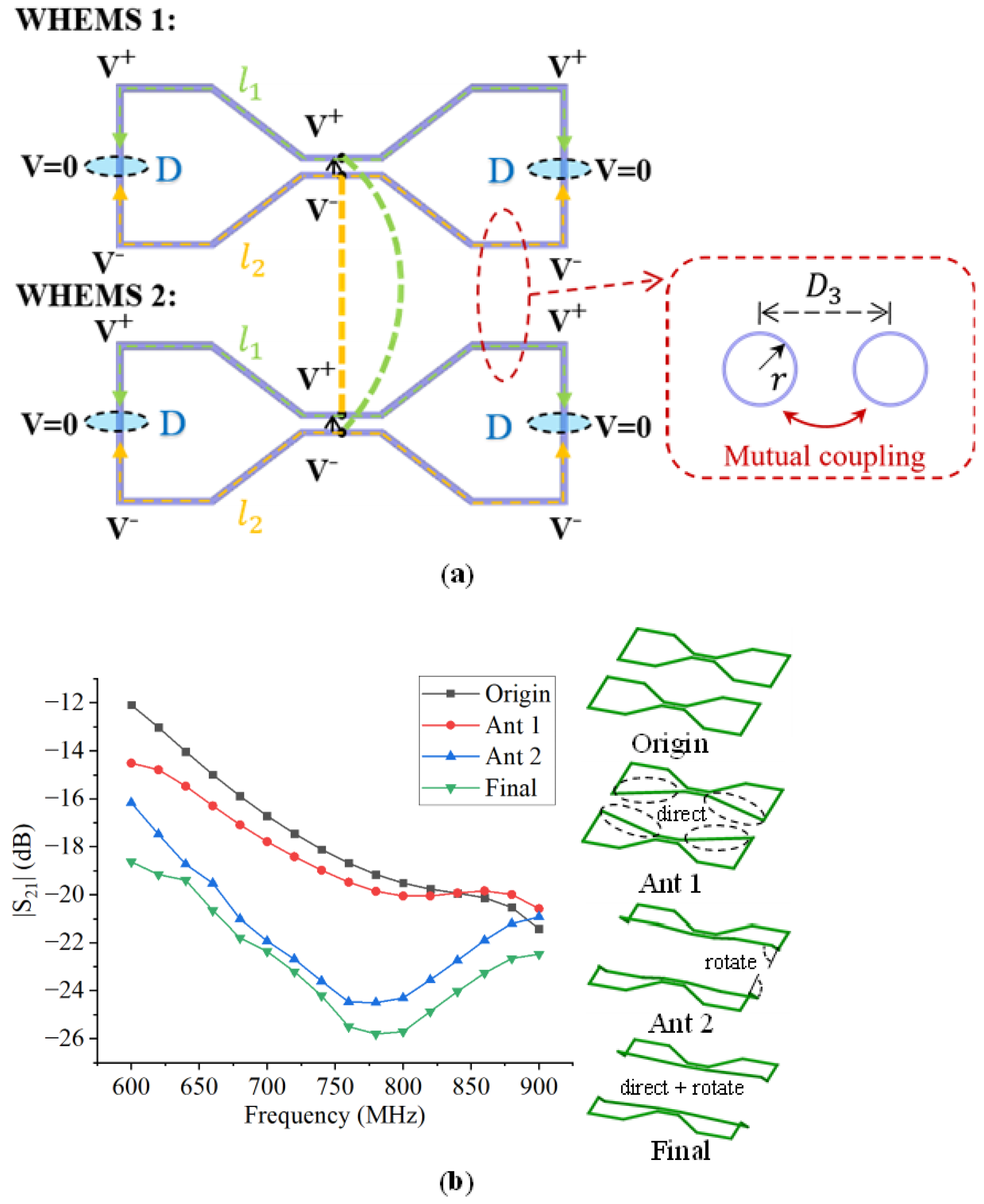
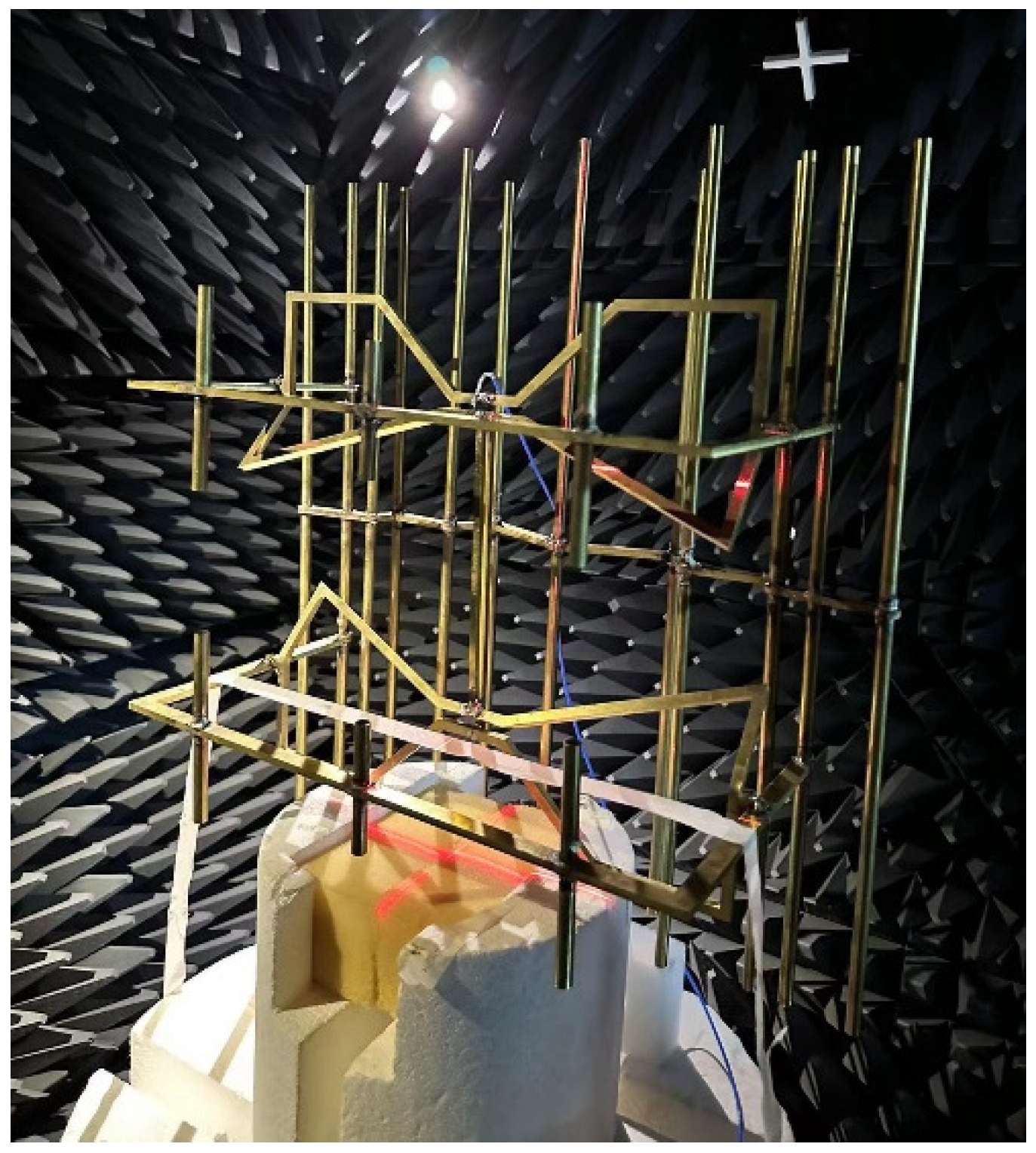
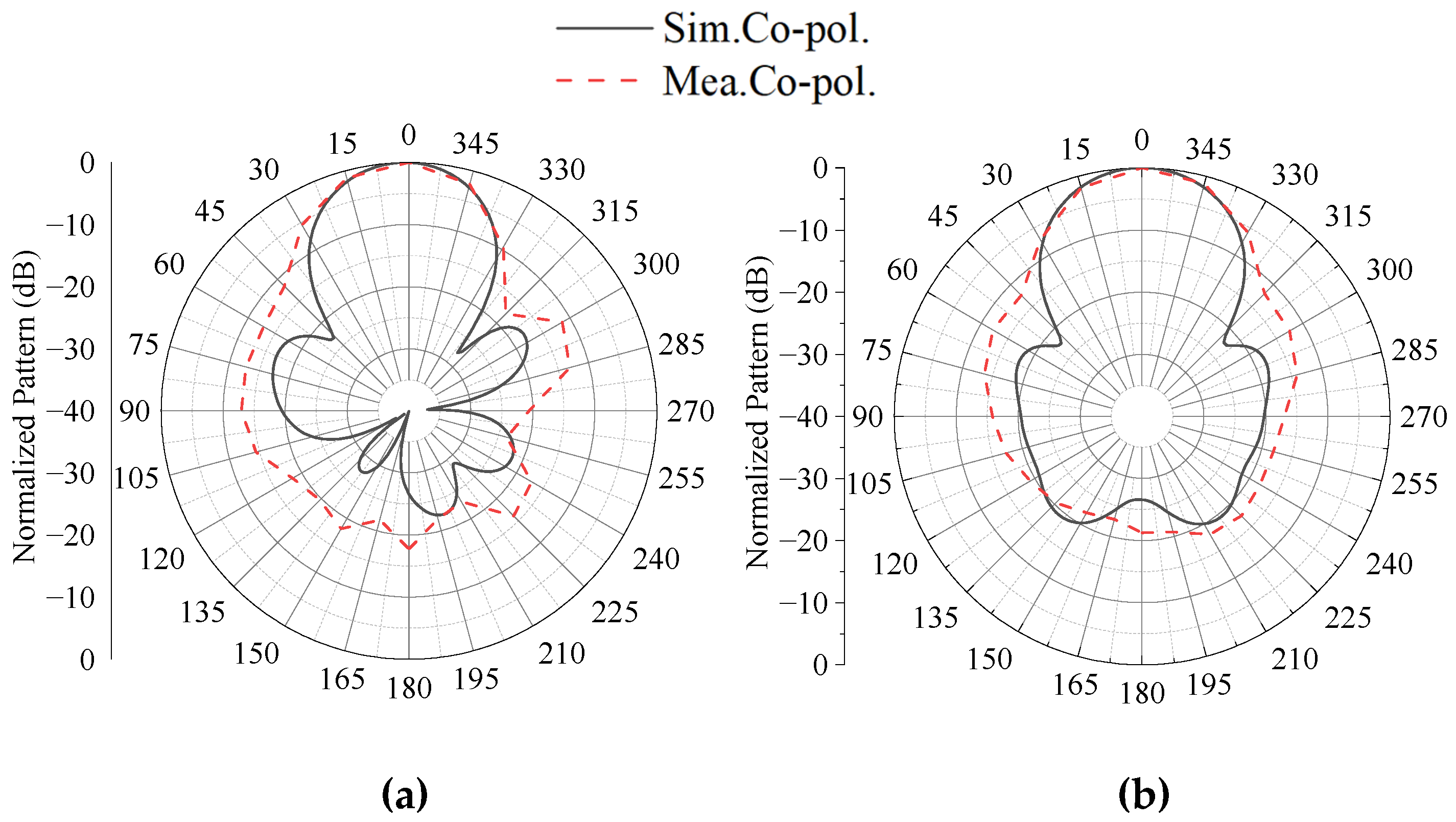

| Ref. | Bandwidth (%) | Efficiency (%) | Size () | Process | Wind Load | Gain (dBi) |
|---|---|---|---|---|---|---|
| [38] | 32.7 | 90–92 | 0.88 × 0.88 × 0.29 | PCB + Metal | high | 8.0–9.0 |
| [39] | 35.3 | NG | 0.71 × 0.62 × 0.29 | PCB | low | 6.5 |
| [40] | 26.7 | NG | 0.73 × 0.44 × 0.10 | PCB + Metal | high | 5.1–8.0 |
| [41] | 55.3 | NG | 0.93 × 0.93 × 0.25 | PCB | high | 8.2–9.1 |
| [42] | 31.6 | 87–92 | 1.05 × 0.66 × 0.22 | Metal + Plastic | high | 9.8 |
| [43] | 5.4 | NG | 1.83 × 1.83 × 0.54 | All-metal | low | 15.1 |
| [44] | 14.4 | NG | 2.48 × 0.67 × 0.23 | All-metal | low | 12.1 |
| [45] | 25.1 | NG | 1.63 × 0.69 × 0.23 | All-metal | low | 10.1 |
| This antenna | 19.9 | 93–100 | 1.37 × 1.22 × 0.56 | All-metal | low | 14.2 |
Disclaimer/Publisher’s Note: The statements, opinions and data contained in all publications are solely those of the individual author(s) and contributor(s) and not of MDPI and/or the editor(s). MDPI and/or the editor(s) disclaim responsibility for any injury to people or property resulting from any ideas, methods, instructions or products referred to in the content. |
© 2024 by the authors. Licensee MDPI, Basel, Switzerland. This article is an open access article distributed under the terms and conditions of the Creative Commons Attribution (CC BY) license (https://creativecommons.org/licenses/by/4.0/).
Share and Cite
Chi, L.; Xie, L.; Weng, Z.; Qi, Y. Progress on Single-Feed Quality Wideband Linear Wire Array. Telecom 2024, 5, 977-991. https://doi.org/10.3390/telecom5040049
Chi L, Xie L, Weng Z, Qi Y. Progress on Single-Feed Quality Wideband Linear Wire Array. Telecom. 2024; 5(4):977-991. https://doi.org/10.3390/telecom5040049
Chicago/Turabian StyleChi, Lidong, Lingxiao Xie, Zibin Weng, and Yihong Qi. 2024. "Progress on Single-Feed Quality Wideband Linear Wire Array" Telecom 5, no. 4: 977-991. https://doi.org/10.3390/telecom5040049
APA StyleChi, L., Xie, L., Weng, Z., & Qi, Y. (2024). Progress on Single-Feed Quality Wideband Linear Wire Array. Telecom, 5(4), 977-991. https://doi.org/10.3390/telecom5040049







